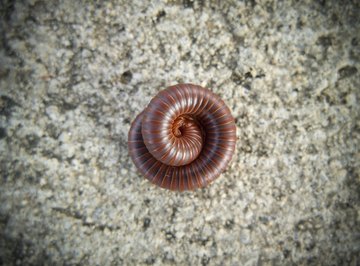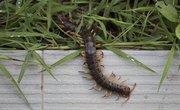
Although the name millipede means "one thousand feet" and the small invertebrates may appear to have hundreds, most millipedes actually have fewer than 100 feet. There are about 1,400 types of millipedes in the United States and Canada, and about 7,000 across the world. Millipedes are mostly harmless, and they break down dead plants and improve the soil. They don't bite, but you shouldn't pick up a millipede with your bare hands because they can release a chemical that irritates skin.
Millipede Body Structure
Millipedes look like insects or worms, but they're more closely related to crayfish, lobsters and shrimps. Most millipedes have round, segmented bodies, and nearly all the segments have two legs. The segments at the front and rear of their bodies have no legs, and the first three segments have one pair of legs.
The known greatest number of legs on a millipede is 750, while the lowest known number is 22. A hard outer shell called an exoskeleton protects most millipedes, and brown or black are common millipede colors. A brightly colored millipede is a sign to predators that it gives off bad smells or toxic chemicals.
The smallest millipedes are three mm (0.1 inches) and the largest millipedes can reach 305 mm (12 inches). At the bases of millipede antennae are structures called Tömösváry organs, which help them sense what's happening around them. Most millipedes also have eyes on the sides of the head.
Millipede Behavior
Millipedes are nocturnal and live in dark, damp places. During the day, they live under leaf litter, rotting logs and rocks, where they're protected from very hot or cold temperatures and predators. When they come out at night, they feed on dead and decaying vegetation and wood.
Where there are many millipedes, they sometimes cause problems in gardens by eating seedlings. Some types of millipedes also eat dead animals such as snails, and some eat living plants. Millipedes are good at burrowing, and their many legs cause them to walk in a wavelike pattern. Compared to the similar-looking centipede, millipedes are slow moving.
Life Cycle of Millipedes
The life span for millipedes is between seven and ten years, and after two to five years, they're ready to reproduce. Male millipedes appear not to have legs on either the seventh or the last ring of the bodies, and in some male millipedes, the legs are actually folded into the body and help form reproductive structures.
In females, the sex organs are behind the second pair of legs. After mating, most female millipedes lay 20 to 30 eggs in warm soil, although some give birth to live baby millipedes. Legless larvae hatch from the eggs.
Millipedes lose their hard shell when they grow larger. This is called molting. At the first molt, millipede larvae develop legs, and at each molt the number of segments increases. Millipedes eat their old exoskeleton after molting to avoid wasting a valuable source of food.
More Interesting Millipedes
Among the largest types of millipedes are the North American millipede and the giant African millipede. The North American millipede grows up to ten cm (3.9 inches) long, and is dark reddish-brown or black with a red line on each segment. Females lay a single egg in a nest of regurgitated food, and wrap themselves around it to incubate the egg.
Giant African millipedes are the world's largest known millipedes, growing up to 30.5 cm (12 inches) long. They live in rain forests and have 30 to 40 segments.
Another fascinating group of millipedes are those belonging to the genus Motyxia. Millipedes in the genus Motyxia live in mountainous areas of California. They are bioluminescent and glow greenish-blue at night, which may be a way for these types of millipedes to scare off predators.
References
About the Author
A graduate of Leeds University, Jenny Green completed Master of Arts in English literature in 1998 and has been writing about science since 2007. Green's work appears in Synonym, Sciencing, and other websites and ezines
Photo Credits
raaisma/iStock/Getty Images
